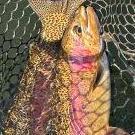
Like that pun? " . . on the rise" . . . Well, I thought it was a pretty creative lead-in for me.
What do Taneycomo rainbows eat the most, midge flies, scuds or sow bugs? If you look at the pure numbers of each bug, you have to say the midge fly is the answer. And another thing, is the plural of midge midges? I always have a hard time with writing about the insects because I don't know what to call them. There are pupas, larvae, emergers and dries, but I refer to them as just midges in this piece.
I'm not going to get too technical about this . . . I want to educate you on just a couple of things -- how to read the conditions and how to fish midge flies effectively.
Wouldn't reading conditions be... easy? You see trout dimpling the surface, and you say, "They're eating midges in the film or off the surface -- let's use a zebra or a soft hackle!" Yes but they eat midge pupae and larvae without showing any visible signs of eating anything at times . . . on the surface, anyhow.
On Taneycomo, there are conditions we have learned to find for certain reactions from both bugs and trout, namely when the water is dropping from generation and during early mornings and late evenings. There have been times when we are drifting below the dam with water running and notice, all of a sudden, trout midging like there's no tomorrow. At the same time we notice a wet line on the bank indicating that the water level is dropping, or the opposite can happen. We notice the water dropping and then the increase of surface activity. But then there are times when the water drops and there's no activity, that we can detect. That's when we look deeper, deeper -- nothing mystical--just deeper in the water. We look for fish moving from side to side, rising and falling in the water column, eating larvae that are rising to the surface.
It surprises me that freshly stocked rainbows adapt so quickly to their new environment. Where rainbows are stocked downstream like in the Cooper Creek area and even as far down as the Branson area between the bridges, they are seen readily taking midges off the surface even the day they are stocked. Surprising... but seemingly a good thing for their survival. Or is it?
A fly that has been mentioned time and time again in my fishing reports has been the zebra midge. This little, simple fly imitates a midge larva to a tee, except we use red a lot, and they aren't red at all. For the most part they're black, sometimes cream or brown, and sometime olive. But the shape -- thin and short with a bead head for the head -- apparently makes a good impression on a trout.
The fly can be tied several ways -- with a tungsten bead, glass bead or regular cyclops bead, thread or vinyl rib body and ribbed with bare or coated wire or not ribbed at all. Some tyers tie a turn of peacock below the bead to give it a hairy look. Some tie a little crystal flash coming out of the head imitating wings emerging. But the plain-Jane zebra has caught this angler a ton of trout without all the fancy add-ons. We usually tie them on a curved, nymph hook such as a 2487 TMC, but I've seen them on other styles as well.
This fly, or the technique of catching trout, isn't limited to fly rod fishing at all. As a matter of fact, our guides have been fishing the zebra exclusively the last month using spin rods, two-pound line and a small indicator, with little trouble catching fish. And in most cases, they've been fishing down lake, not up in the trophy area. Buster Loving and Bill Babler haven't even started their big motors at times, trolling to the middle of the lake here at the resort or off the public boat ramp at Cooper Creek to start and finish their trips. They catch more than most clients ever thought of seeing in a four-hour period.
Depth isn't necessarily a big guessing game.The trout are either relatively close to the surface or just a little deeper. A good rule of thumb is to set your indicator 12 to 18 inches if there's surface activity and three to four feet when there's not.
Seeing the strike is no guessing game at all. Whether you're fishing a pinch-on indicator or a one-inch carrot float, these trout seem to be aggressive on the take. The float goes under -- and sometimes sideways -- in a hurry.
All in all, fishing a zebra midge under a float has almost replaced the popular jig-n-float technique. If our trout keep keying in on it, the rise in use will not be a surprise.


Recommended Comments
There are no comments to display.
Create an account or sign in to comment
You need to be a member in order to leave a comment
Create an account
Sign up for a new account in our community. It's easy!
Register a new accountSign in
Already have an account? Sign in here.
Sign In Now